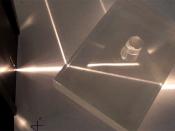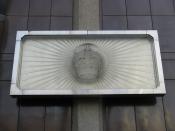PLANNING: -
Title: - An Experiment to investigate the lateral displacement of a ray of light through a rectangular block of a transparent material.
Aim: - To investigate the lateral displacement for different angles and how the displacement depends on the angle of incidence when a ray of light enters the Perspex block.
Scientific Background: -
Refraction occurs when the speed changes when the lights travels from one medium to another medium. If the light travels from a medium to a denser medium, the light slows down and consequently is refracted towards the normal. If the light travels from one medium to a less dense medium, the speed increases and as a result, the light is refracted away from the normal.
A measure of how much the light is refracted is the refractive index that can be symbolized to the letter, n which is referred to Snell's law: -
When light is refracted, an increase in the angle of incidence, I, produces an increase in the angle of refraction, r.
The scientist, Willebrord Snell discovered the link between the two angles where their sines are always in proportion to each other. So, when light passes from one medium into another, the following equation can be formed from Snell' law: -
Sin i is constant
Sin r
An example of this is illustrated below in the diagram: -
V1
i
r
D
V2
(where: i=15o angle of incidence
r=10o angle of refraction
V1 = speed of light in vacuum
V2 = speed of light in medium
D = depth of Perspex block)
The refractive index can be found having this information: -
Sin 15 = 0.26 = 1.5o
Sin 10 0.17
The formula sin i can also be written as V1
Sin r V2
A ray of light is bent...


